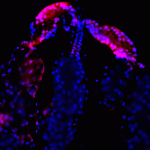Link to Pubmed [PMID] – 17065316
Proc. Natl. Acad. Sci. U.S.A. 2006 Nov;103(45):16858-63
Serpins are central to the modulation of various innate immune responses in insects and are suspected to influence the outcome of malaria parasite infection in mosquito vectors. Three Anopheles gambiae serpins (SRPN1, -2, and -3) were tested for their ability to inhibit the prophenoloxidase cascade, a key regulatory process in the melanization response. Recombinant SRPN1 and -2 can bind and inhibit a heterologous phenoloxidase-activating protease and inhibit phenoloxidase activation in vitro. Using a reverse genetics approach, we studied the effect of SRPN2 on melanization in An. gambiae adult females in vivo. Depletion of SRPN2 from the mosquito hemolymph increases melanin deposition on foreign surfaces such as negatively charged Sephadex beads. As reported, the knockdown of SRPN2 adversely affects the ability of the rodent malaria parasite Plasmodium berghei to invade the midgut epithelium and develop into oocysts. Importantly, we tested whether the absence of SRPN2 from the hemolymph influences Plasmodium falciparum development. RNAi silencing of SRPN2 in an An. gambiae strain originally established from local populations in Yaoundé, Cameroon, did not influence the development of autochthonous field isolates of P. falciparum. This study suggests immune evasion strategies of the human malaria parasite and emphasizes the need to study mosquito innate immune responses toward the pathogens they transmit in natural vector-parasite combinations.

